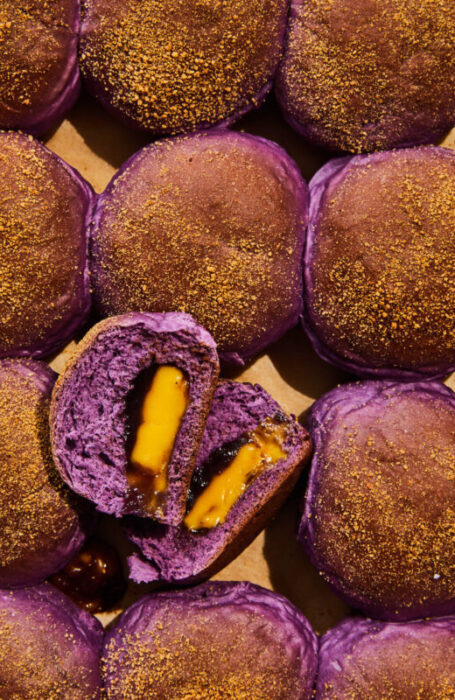Pandesal translates to “salt bread” in Spanish but it doesn’t taste salty. Instead, it’s the ideal canvas for smearing with myriad spreads and plunging into steaming cups of warm beverages. It’s as ubiquitous as bagels in New York or baguettes in France. It’s iconic. A national treasure.
What I love about this dish is that it reminds us how food can tell the story of history, and not just our personal ones. It’s a marker for critical events, like the pandemic in this case. And how, in the bleakest times, you can find comfort and community in making something familiar, something new.
Makes 20 rolls
WHAT YOU NEED
For the dough
4 tbsp unsalted butter
1 cup (240g) whole milk
66g plus 2 tablespoons (25 g) granulated sugar, divided
7g active dry yeast
83g ube halaya, at room temperature
1 large egg, at room temperature
1 teaspoon ube paste
468g all-purpose flour
1½ teaspoons kosher salt
For the filling
¾ cup plus 1 tablespoon (200g) ube halaya, cold
Twenty 5 g-pieces Velveeta cheese, shaped into 1-inch (2.5 cm) coins (see *Note)
Editor’s note: Velveeta cheese is an American processed cheese. In Australia it can be substituted with Swiss or cheddar cheese.
¼ cup (25g) finely crushed cracker crumbs
*Note: To portion the 5g pieces of Velveeta cheese, cut half of a 16 oz. (450g) block into 24 even squares (you’ll only use 20 pieces).
WHAT TO DO
For the dough
In a small saucepan, melt the butter over low heat. Whisk in the milk and heat until an instant-read thermometer registers between 110° and 115°F (43° and 46°C).
Remove from the heat. Add 2 tablespoons (25g) of the sugar, sprinkle the yeast over top, and whisk to combine. Let sit undisturbed until foamy, about 5 minutes. Whisk in the ube halaya, the egg, the remaining ⅓ cup (66g) of sugar, and the ube paste.
Fit a stand mixer with the dough hook. In the stand mixer bowl, whisk together the flour and salt. Add the yeast mixture and stir with a fork until a sticky dough comes together.
Fasten the bowl into the stand mixer and knead on medium speed, scraping down the sides of the bowl halfway through, until the dough is smooth, stretchy, and no longer sticky, 7 to 10 minutes.
Grease a large bowl with cooking spray. Shape the dough into a ball and place it into the bowl. Flip the dough over (this greases both sides). Cover tightly with plastic wrap. Let rise in a warm place until puffed and nearly doubled in volume, about 2 hours.
To assemble
Press the dough down with your fist to expel the air and transfer to an unfloured work surface.
Divide the dough into 20 equal portions (about 48g each). Keep the portions loosely covered with plastic wrap while you work.
Line a sheet pan with parchment paper. Working with one portion of dough at a time, cup your hand over the dough and roll it around in a circular motion against the work surface until it forms a smooth ball.
Using your hand, flatten the ball into a 2 ½-inch (6.5 cm) round. Add 2 teaspoons (10g) of ube halaya to the center of the dough and press a cheese coin into it. Bring up the edges of the dough, and pinch to seal. Dip the top of the bun into the graham cracker crumbs and place seam-side down on the lined pan, arranging the buns in five rows of 4, spacing them 1 inch (2.5cm) apart.
Cover loosely with plastic wrap. Let rise in a warm place until puffed and expanded in size about 50 per cent, about 1 hour. (The buns will not be touching, but the gaps between them should be almost closed).
Meanwhile, preheat the oven to 350°F (180°C).
Bake until puffed, the buns are touching, and an instant-read thermometer inserted into the side of one of the middle buns registers 190°F (88°C), about 20 minutes.
As soon as they come out of the oven, transfer the pan to a wire rack and cover loosely with a tea towel for 10 minutes (this helps them soften a bit). The filling can be quite hot so just be mindful.
Store in a resealable plastic bag in the refrigerator or freezer. Reheat in the microwave






COMMENTS